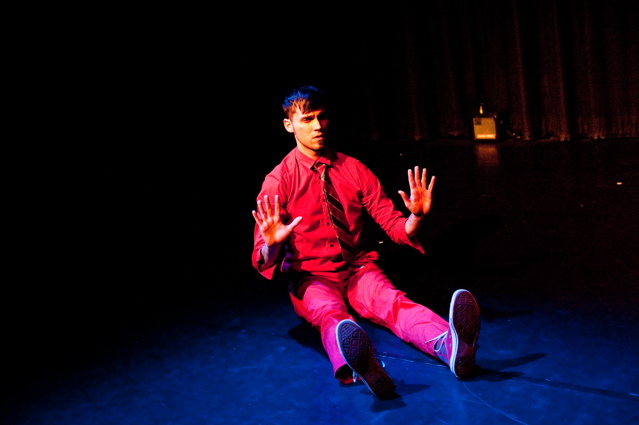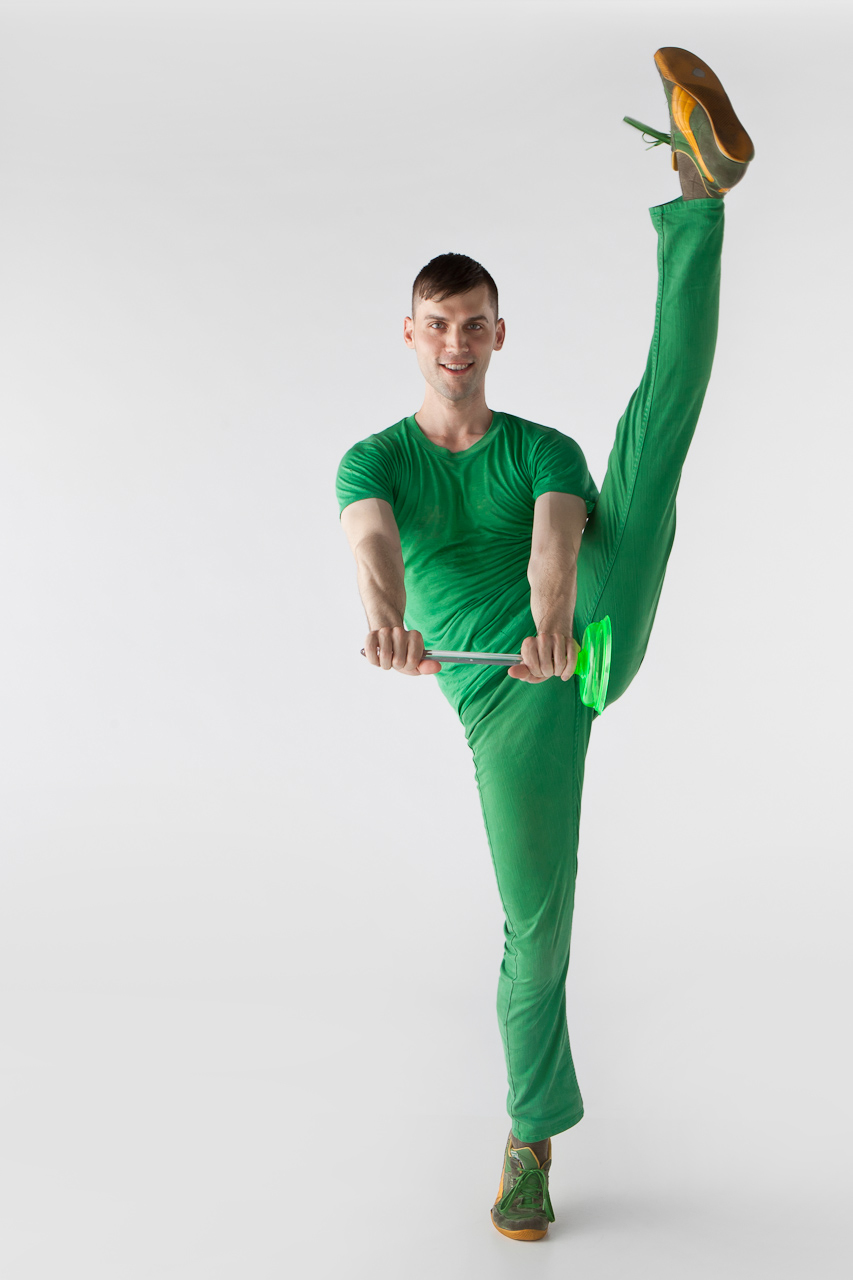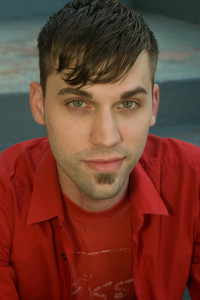by Jamie Benson
Lights come up on a lone figure, the one burdened with putting a trance over a packed house of smart phones. It’s a tall order to be sure. You don’t just have to dazzle, you have to captivate, ooze an indisputable it-factor that dares an audience of TV brains to look away, as if they could. The best/worst part is that you probably put yourself in the position to be this dance mystic. It’s your fault.
It’s your solo after all.
In an attempt to simplify my life as a choreographer (Ha!), I recently dove headfirst into the idea of making new solos. This was after previously doing a lot of ensemble pieces. It’s more freeing and more terrifying than ever. You’ve been there right? (Or will be.) Let’s have some group therapy real quick and see if we can come out the other end a little wiser, a little more capable of entrancing our next packed house. Game? Good.

Potential Pitfall: How Does It “Read” (a.k.a Do I look nuts?)
It can be tricky to clearly represent the source of whatever emotion one is exploring as a soloist and harder to suss out how it might “read” to an innocent audience-goer. There’s a more immediate response when working with other performers. They laugh when it’s funny, look at you cross-eyed when it’s too complicated or unintentionally awkward, and so on and so forth. As audience members, we’ve all experienced that performance where a soloist goes from poised dancer to insane person in seconds flat. As choreographers we think we know how something looks from the outside because we feel it so deeply. But as an audience member, one can become perplexed and feel alienated really fast if there’s no immediate access point, such as a topical reference, a common emotional gesture, something. Even if we deliberately create space for the audience to make their own choices about what we’re doing, our job is still ultimately to communicate something through movement.
Tip: Peer review is your best friend. Ask those you trust, dancers AND non-dancers, to bear witness to your rehearsal process. Ask them what they see. Make sure to have worked out as many kinks as you can first so they aren’t responsible for putting too much work into understanding your vision.
Bliss: Complete Freedom
When doing solo work you are completely free from both scheduling and paying ridiculously busy, creative people. Again, you are (terrifyingly) free.

Potential Pitfall: Crafting A Relationship With Yourself
Relationships can drive a performance. Conflict drives a story forward. Some thing is usually at odds with some other thing, whether it gets resolved or not. When choreographing a group, you’re already conjuring some context or possible conflict just by how the dancers are arranged on the stage. With my work personally, rarely are a group of dancers just bodies attempting to be interesting onstage. I get preoccupied with the relationships, whether implied or straightforward. The composition of the dancers in space already implies a relationship. Are they confrontationally facing each other from across the space, or dancing side by side and facing the same direction? That one choice already adds intrigue to the work.
There is an innate, cerebral quality inherent in a solo, something more internal about the “character” or symbol the dancer represents. You almost have to create a clear relationship with yourself to do it justice I think. One that hopefully translates universally to the internal lives of those watching.
Tip: Ask yourself what opposing forces or emotions inspired you to make the dance you’re making. What’s going on in your life right now? Maybe try putting objects of immediate meaning to you in different parts of the studio. As you move to and from the objects see if it brings out anything unique in your performance while you rehearse.
Bliss: Really Devouring Space
Unless limiting your performance space is really specific to the story you’re selling an audience, as a soloist you have an opportunity to go wild with using the space. Finally, there are no people to avoid hitting. You are again free. It’s so sad when a soloist doesn’t utilize the entire performance space, venue or site. Dance in a corner for a while. Use the aisles. Do something creative with a unique architectural aspect of the site. See how that may inform what you’re saying with the work. Plus, using the space in unexpected ways will keep an audience intrigued and don’t we all want that as choreographers?

Potential Pitfall: Coming Across As Self-Indulgent
Solo work can be easily perceived as overt self-indulgence. Hell, choosing to be a dancer might in fact be a little self-indulgent already (a different article perhaps). It’s a fine line to walk, in dance. You’re there, alone, doing whatever you feel like. There is no one else to blame if your audience starts to feel like you’re not editing your work enough, that you aren’t there to share with them as much as you’re there to fulfill your own creative whims. Look, I’m not saying any of us are doing this but it can be perceived as such.
Solution: Present your work at as many informal showings as possible. Get feedback and, more importantly, take it seriously. I see dancers get defensive about their work, finding reasons to discredit constructive feedback. Stop that. You don’t have to take everyone’s advice because honestly you’ll receive contradictory opinions. But, let the feedback in with a spirit of compassion and generosity. Your work is a gift you give the world. Check to see what the world likes about what you’re doing and perhaps what they don’t. If you make decisions to defy them after the fact at least you do it knowingly, with a clear conscious and a possible rebuttal should you get any resistance.
Bliss: You ARE Doing Whatever You Want.
In that all too fleeting of a moment, when dancing for others, you are quite literally a boss. You’ve cracked the code that so many strive for. Whatever the consequences, enjoy that bunch of moments.

Potential Pitfall: Every Moment Is Make-or-Break
Everything is more crucial during a solo. There’s less to distract the audience from what is happening to you. Authentic emotional expression, free of self-consciousness in every single moment is something one must cultivate, commit to and relax into. An audience can smell insecurity, both figuratively and possibly literally in a dancer’s case. Pay more attention to the details and execute them with as much conviction as you can.
Solution: Don’t rush too much through the performance or the rehearsal process. Choreographed stillness is a good way to challenge your potential impact on an audience. A soloist that can really allow moments to happen and reverberate shows our audience that we’re not afraid to just “be” in front them. It can really draw a spectator in if you own it. Confidence is key.
Bliss: Solos Make You A Better Performer
True bliss comes when you challenge yourself to keep an audience enthralled with your every move (literally), and it works. It’s a formidable task that, if successful, will make you a more present, more powerful performer, whether alone or in an ensemble.
As with anything, the moral of the story is to put the work in. And then, put in some more and no one can take the satisfaction and power you’ve gained away. Now, get to work and good luck! You’re audience is rooting for you to succeed you know. I am too. Great group session everyone, have a lovely day. There are cookies and coffee on your way out.

Jamie Benson, proclaimed as “one of the strongest, hottest contemporary dancers of his generation” by LA critic Lewis Segal, is a New York-based dancer, choreographer and Alumnus of Cornish College of Art. Heralded as “Chaplin-like” by Backstage West, Benson garnered critical attention in LATC’s Ovation Award winning Shag with a Twist, the film Rent, McDonald’s Mario Art commercial, TV series Dance360, Rudy Perez Ensemble and Sylvain Emard’s Le Grand Continental. He currently dances with Bardos Ballet Theater and RedWall Dance Theatre.
As a choreographer, Benson aims to defy performance traditions through dynamic, accessibly original, 21st Century work. Coined as “insightful and irreverent” by Ann Haskins from the LA Weekly, Benson’s lowbrow-meets-highbrow choreographic work has been presented at the Luckman Fine Arts Complex, Highways Performance Space, the Bootleg Theater, Triskelion Arts, New York Transit Museum and Dixon Place. His work has also been featured in the New York and Los Angeles Times as well as the Phaidon Press book Wild Art. In 2013, Benson received a residency from the Joyce Theater to found the Shakedown Dance Collective for dancers of all sizes and experience levels. Jamie Benson also contributed choreography to Jesse Schoem’s short film United, Fatelink Production’s web series Dumbass Filmmakers, and the West Hollywood production of Mart Crowley’s gay anthem play, The Boys in the Band. As a filmmaker, Benson’s short 3 Day Weekend was an official selection for the 2014 Cinedans Film Festival and his latest short First Thing will premiere in Greece as part of the Athens Video Dance Project in January of 2015. To learn more visit jamiebenson.com.





I really like your Blog it was a very good read and I found some great inspiration from it for my solo I am currently working on! Thankyou for sharing.
I enjoyed reading this, I find making a solo piece of choreography really difficult, the points you made are really going to help me with some more creative choreography! Thank you.
Hooray! Then it was all worth it Alika. Thanks for reading me up. Good luck with your next solo! Let us know how it goes. j
Inspiration? Fantaaaastic Carol, that is the goal. Very happy to be of service. I just debuted my solo “FOMO” last night and it was a nerve wracking process. Writing this article definitely helped me to cope with it too. Warmly, Jamie
I thoroughly enjoyed reading this. I think it makes excellent points about the process of making up a solo . I will defiantly think of this blog when making up my next solo, thank you for sharing.
Claudia – thanks so much for the feedback and all best to you on your dance endeavors!
That is all I hope for when I write this stuff Claudia. Let me know if anything specific I wrote helps during your next creative process Thanks a million, j